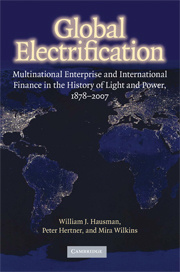 Global Electrification
Global Electrification Book contents
- Frontmatter
- Contents
- Tables and Illustrations
- Series Editors' Preface
- Preface
- Acknowledgments
- Authors and Contributors
- PART I CONCEPTS
- PART II CHANGES
- PART III CONCLUSIONS
- 6 Summary of the Domestication Pattern to 1978
- 7 Coming Full Circle, 1978–2007, and a Global Perspective
- Appendix A: Abbreviations, Acronyms, Company Names, and Variations on Company Names
- Appendix B: Notes to Table 1.4 Foreign Ownership of Electric Utilities, Four Periods
- Notes
- Select Bibliography
- Index
7 - Coming Full Circle, 1978–2007, and a Global Perspective
Published online by Cambridge University Press: 26 July 2009
- Frontmatter
- Contents
- Tables and Illustrations
- Series Editors' Preface
- Preface
- Acknowledgments
- Authors and Contributors
- PART I CONCEPTS
- PART II CHANGES
- PART III CONCLUSIONS
- 6 Summary of the Domestication Pattern to 1978
- 7 Coming Full Circle, 1978–2007, and a Global Perspective
- Appendix A: Abbreviations, Acronyms, Company Names, and Variations on Company Names
- Appendix B: Notes to Table 1.4 Foreign Ownership of Electric Utilities, Four Periods
- Notes
- Select Bibliography
- Index
Summary
After the long process of domestication, which included numerous nationalizations of electric utilities and during which foreign ownership had all but disappeared, the political landscape shifted rather dramatically in the late 1970s and early 1980s. In many countries, government-owned electric utilities now were being criticized for their poor performance, high costs, and unreliable supply, problems (especially in less developed and developing countries) deemed to have been caused by inadequate maintenance and expansion due to the inability or unwillingness of the state to invest needed capital. By the end of the 1980s and throughout the 1990s, new government policies of liberalization, privatization, and utility restructuring were being implemented in many countries. These policy changes, along with loosened restrictions on capital outflows and inflows, opened up the prospects for renewed foreign direct investments, and once again companies began investing in foreign electric utilities. As the International Energy Agency (IEA) – a unit of the Organization for Economic Cooperation and Development (OECD) – stated in one of its “Messages for Governments” in 1994, “Investment by international electric companies in other markets plays an important role in transferring technology and capability/knowledge, as well as improving technical and economic efficiency, capital availability, energy security, and the environment.” Such statements viewed foreign direct investment as desirable. Today, cross-national ownership patterns of electric utilities again have become quite common.
- Type
- Chapter
- Information
- Global ElectrificationMultinational Enterprise and International Finance in the History of Light and Power, 1878–2007, pp. 262 - 276Publisher: Cambridge University PressPrint publication year: 2008
